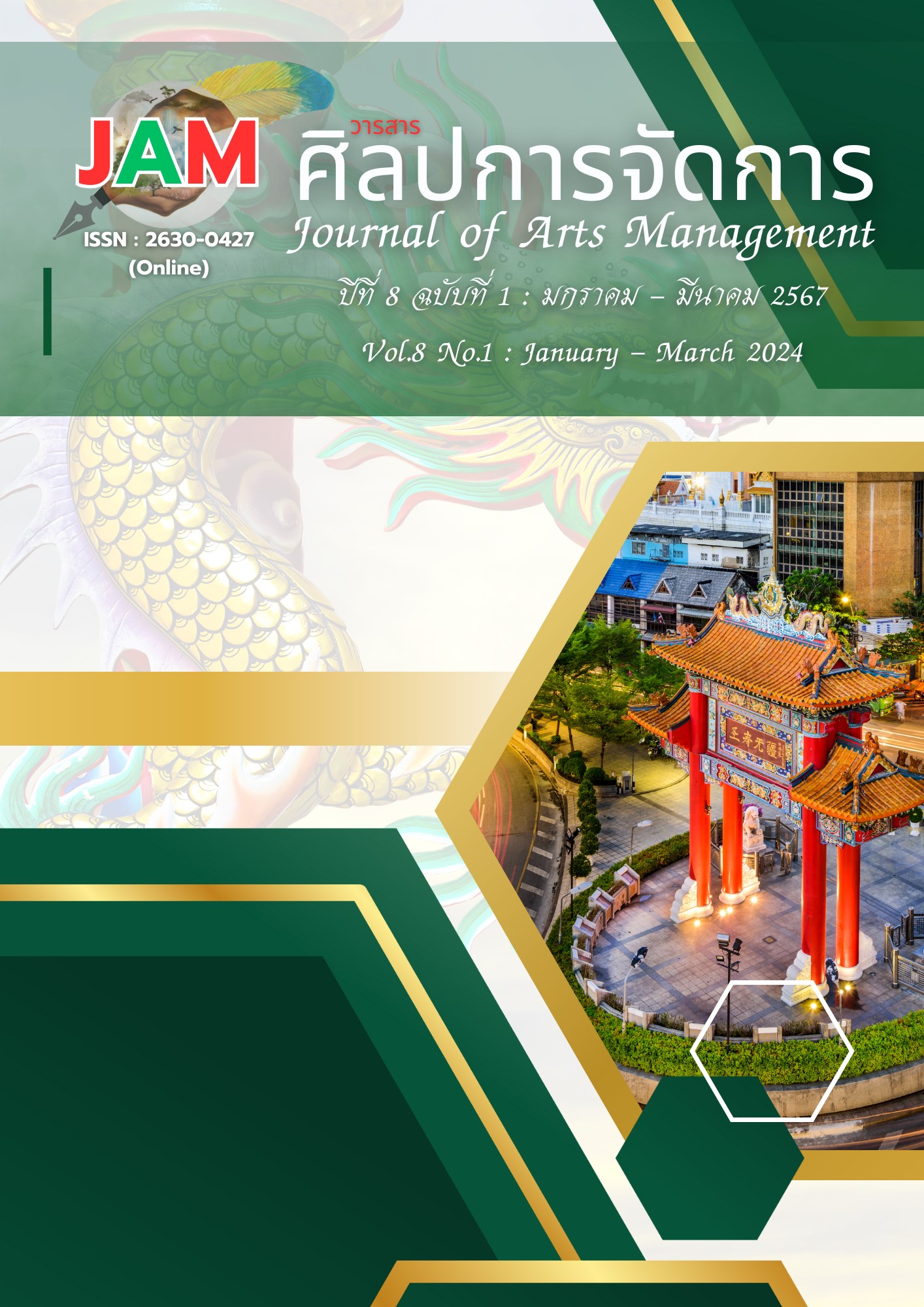The Guidelines for Business Operation Development in the Digital Age of the Film and Video Industries in Thailand
Main Article Content
Abstract
The research on the guidelines for business operation development in the digital age of the film and video industries in Thailand has the following objectives: 1) To study the factors influencing the development of business operations in the digital age of the film and video industries in Thailand. 2) To create a structural equation model of the factors influencing the development of business operations in the digital age of the film and video industries in Thailand. The study focuses on a sample group of business entrepreneurs in film and video production activities, consisting of 400 companies. The data is analyzed using structural equation modeling. The research adopts a mixed-methods approach, combining quantitative and qualitative methods. The research tools include questionnaires and in-depth interviews. The quantitative research found that: 1) Six factors, namely information technology, learning orientation, external environment, innovation capability, organizational agility, and balanced scorecard, significantly influence the development directions of business operations in the digital era of the film and television production industry in Thailand. 2) The structural equation model developed by the researchers aligns with observational data according to specified criteria: 2/df =1.729, P-Values = 0.736, CFI = 0.994, GFI = 0.976, RMSEA = 0.049, RMR = 0.021. The qualitative research found that business operations in the digital age of the film and video industries, with six studied factors, are crucial for driving organizational success in the film and television production industry. Importantly, every company is willing to embrace various changes, strategically plan to cope with different situations, and retain skilled personnel to ensure continued business operations.
Article Details

This work is licensed under a Creative Commons Attribution-NonCommercial-NoDerivatives 4.0 International License.
Views and opinions appearing in articles in the Journal of Arts of Management It is the responsibility of the author of the article. and does not constitute the view and responsibility of the editorial team I agree that the article is copyright of the Arts and Management Journal.
References
AL-Hanandeh, R. M. (2020). The moderating effect of analytical decision-making culture on the relationship between business intelligence drivers and organisational agility: Empirical study in Jordanian banking sector. Global Journal of Information Technology: Emerging Technologies, 10(2), 113–127. https://doi.org/ 10.18844/gjit.v10i2.4763
Chong, P., Ong, T., Abdullah, A., & Choo, W. (2019). Internationalisation and innovation on balanced scorecard (BSC) among Malaysian small and medium enterprises (SMEs). Management Science Letters, 9(10), 1617-1632. DOI:10.5267/j.msl.2019.5.025
Delone, W. H., & McLean, E. R. (2003). The DeLone and McLean model of information systems success: A Ten-year update. Journal of Management Information Systems, 19(4), 9-30. DOI:10.1080/07421222.2003.11045748
Department of Business Development. (2022). Business group entrepreneurs Film and video production activities. https://www.dbd.go.th
Film Archieve (Public Organization), Thailand. (2020). Information about the movie. Film Archieve (Public Organization), Thailand.
Hair, J. F., Gabriel, M., & Patel, V. (2014). AMOS covariance-based structural equation modeling (CB-SEM): Guidelines on its application as a marketing research tool. ReMark - Revista Brasileira de Marketing, 13(n.2), 44-55. DOI:10.5585/remark.v13i2.2718
Hassan, N. H., & Arshad, N. I. (2019). Proposing construct for organizational agility model in Malaysian automotive organization. In 2019 6th International Conference on Research and Innovation in Information Systems (ICRIIS) (pp. 1-6). IEEE. https://ieeexplore.ieee.org/abstract/document/9073673
Kaplan, R., & Norton, D. (1996). Using the balanced scorecard as a strategic management system. Harvard Business Review, 74(1), 75-85.
Khan, F., Ahmed, W., & Najmi, A. (2019). Understanding consumers’ behavior intentions towards dealing with the plastic waste: Perspective of a developing country. Resources, Conservation and Recycling, 142, 49-58. https://doi.org/10.1016/j.resconrec.2018.11.020
Kirkpatrick, S. A., Miller, S. C., Terragnoli, A., & Sprenger, A. (2021). Development of an Organizational Agility Assessment for Government and Nonprofit Organizations. Organization Development Journal, (Summer), 67-81.
Kotler, P., Keller, K. L., Brady, M., Goodman, M., & Hansen, T. (2016). Marketing management (3rd ed.). Pearson.
Mamaghani, N. D., Samizadeh, R., & Saghafi, F. (2011). Developing a Combined Framework for Evaluating IT Projects based on IT-BSC and COBIT. International Journal of Digital Content Technology and its Applications, 5(5), 10-22. DOI:10.4156/jdcta.vol5.issue5.2
Navimipour, N. J., Milani, F. S., & Hossenzadeh, M. (2018). A model for examining the role of effective factors on the performance of organizations. Technology in Society, 55, 166-174.
Ridwandono, D., & Subriadi, A. P. (2019). IT and organizational agility: A critical literature review. Procedia Computer Science, 161, 151-159.
Rdiouat, Y., Bahsani, S., Lakhdissi, M., & Semma, A. (2021). Measuring and improving information systems agility through the balanced scorecard approach. IJCSI International Journal of Computer Science Issues, 12(5), 58-71.
Silva, P. (2015). Davis' technology acceptance model (TAM) (1989). Universidade Federal da Paraíba. DOI:10.4018/978-1-4666-8156-9.ch013
Sinkula, J. M., Baker, W. E., & Noordewier, T. (1997). A framework for market-based organizational learning: Linking values, knowledge, and behavior. Journal of the academy of Marketing Science, 25, 305-318. https://doi.org/10.1177/0092070397254003
Tajeddini, K. (2016). Analyzing the influence of learning orientation and innovativeness on performance of public organizations: The case of Iran. Journal of Management Development, 35(2), 134-153. DOI:10.1108/JMD-03-2015-0033
Vij, S., & Farooq, R. (2015). The relationship between learning orientation and business performance: Do smaller firms gain more from learning orientation?. The IUP Journal of Knowledge Management, 13(4), 7-28. https://ssrn.com/abstract=2711157
Wanasida, A. S., Bernarto, I., Sudibjo, N., & Purwanto, A. (2021). The role of business capabilities in supporting organization agility and performance during the COVID-19 pandemic: An empirical study in Indonesia. The Journal of Asian Finance, Economics and Business, 8(5), 897-911. DOI:10.13106/jafeb.2021.vol8.no5.0897


